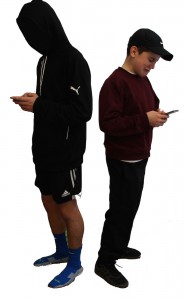
Multiple cases of hurtful comments directed at students have sprung up this year, often on social media sites. These have affected each grade of the middle school. Some middle school students have created anonymous Instagram accounts meant to hurt other members of the middle school community. In some circumstances students made fake accounts impersonating a different student or even once a teacher. In some of those accounts the creators sent Direct Messages or posted comments to purposely upset or put down other students.
This does not follow the ASL core values and can have serious consequences for students. Mr. Peter Lutkoski, middle school principal, Ms. Katie Shefren, middle school assistant principal, and Mr. Payson Bullard, middle school coordinator of student life, hosted various assemblies with different grades and talked about the seriousness of these incidents and how it isn’t acceptable in our community. “It felt that potentially it’s the kind of issue that students don’t know how serious it was,” said Mr. Lutkoski.
“I don’t think of this as a tech issue, more of a core values issue,” Mr. Lutkoski said. Although students used tech in order to try to be anonymous, the bigger issue is the actual act of putting these people down with hurtful comments. “One thing that is concerning about social media is it allows people to be anonymous and it could be tempting for a student to do that because they might think, ‘well nobody will know I was the one doing it,’ but that’s not the case necessarily,” said Mr. Lutkoski.
Unlike the instances where people have created fake accounts to bully others, people sometimes create fake accounts of their friends as a joke. What they do with that account usually is post minimal photos and not contact other people through that account. They are usually doing this for a bit of banter with their friends. Even though the intention is not bad, Mr. Lutkoski doesn’t think this is acceptable. If someone was to look at this account without knowing it was fake, they might think it was real. Even though the creator considers that account a joke, the person who is being impersonated might take serious offence from it. In addition, the person who is being impersonated doesn’t know what the impersonator is doing with their name. There is a long list of things that could be done by the impersonator under someone else’s name that the person being impersonated couldn’t do anything about. This simply could take the power of creating their own digital footprint in the hands of someone else.
Eighth grader Athena Lambropoulos was the victim of a fake Instagram account last year when she was in seventh grade. “Someone took posts off my Instagram account and put them into a different account where they kind of made a joke (of them),” she explained. “They made me feel confused at first. I took it as a joke but then eventually as they kept on posting it made me feel upset and I felt like I didn’t have any power over anything.”
It can be hard to process being targeted by an account, especially when it isn’t intended to hurt the subject. When it’s made as a joke the victim can feel like there’s less reason to reach out for help. Lambropoulos explained how when an account is made, it’s such a confusing experience because you don’t know how to handle it. “The first post really shocked me and alarmed me,” she said. She went on to explain how as more pictures were posted and more people followed and commented on the account, it gave it that much more power.
Mr. Lutkoski, Ms. Shefren and many other faculty members at ASL are doing a lot to help prevent these kinds of things from happening in the future. In health and technology classes, students will be given more instruction on how to make good choices online and how to be an upstander. “We do always talk about these issues in advisory and in class but this will raise the level of importance [of those talks],” said Mr. Lutkoski.
Earlier in this year there was a similar incident where a student made an Instagram account called theasltbher which was intended to hurt people anonymously. Five seventh grade girls took a stand against this incident and presented an assembly to the seventh grade on why this was not okay and what the community could do in the future.
These girls were disappointed that similar situations are still happening. “It’s kind of disappointing because it’s totally going against the Core Values,” said Cala Lindsay, one of the seventh graders who presented the assembly. “After everything we said in the assembly, we just didn’t think that people would do something like that.”
In addition to the online incidents, a seventh grade student has been getting notes in their locker with hurtful comments about them. “It was a shocking thing for me [to learn] because I can’t imagine anyone in our grade doing that,” said Olivia Benjamin-MacDonald, another seventh grader who took part in the assembly at the beginning of the year.
These types of issues seem to have occurred a lot this year, and students can always give support to the victims and try to stop them from continuing or happening again. “Everyone can be an upstander for anyone, to speak up for what’s right,” said Mr. Lutkoski, who explained that if people are upstanders it can help the community stop these issues. “We all want to work together to be in an environment where people respect each other and they feel safe.”
